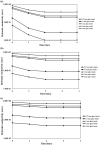Effect of cell density on decrease in hydraulic conductivity by microbial calcite precipitation
- PMID: 35939240
- PMCID: PMC9360383
- DOI: 10.1186/s13568-022-01448-0
Effect of cell density on decrease in hydraulic conductivity by microbial calcite precipitation
Abstract
The effect of number of cells deposited on decrease in hydraulic conductivity of porous media using CaCO3 precipitation induced by Sporosarcina pasteurii (ATCC 11,859) was examined in columns packed with glass beads in the range of 0.25 mm and 3 mm in diameter. After resting Sporosarcina pasteurii cells were introduced into the columns, a precipitation solution, which consisted of 500 mM CaCl2 and 500 mM urea, was introduced under continuous flow conditions. It was shown that hydraulic conductivity was decreased by formation of microbially induced CaCO3 precipitation from between 8.37 * 10-1 and 6.73 * 10-2 cm/s to between 3.69 * 10-1 and 1.01 * 10-2 cm/s. The lowest hydraulic conductivity was achieved in porous medium consisting of the smallest glass beads (0.25 mm in diameter) using the highest density of cell suspension (OD600 2.25). The number of the deposited cells differed depending on the glass bead size of the columns. According to the experiments, 7 * 10-9 g CaCO3 was produced by a single resting cell. The urease activity, which led CaCO3 precipitation, depended on presence of high number of cells deposited in the column because the nutrients were not included in the precipitation solution and consequently, the amount of CaCO3 precipitated was proportional with the cell number in the column. A mathematical model was also developed to investigate the experimental results, and statistical analysis was also performed.
Keywords: CaCO3; Column; Glass beads; Hydraulic conductivity; Microbial clogging; Microbially induced calcium carbonate precipitation; Number of cells; Optical density; Sporosarcina pasteurii.
© 2022. The Author(s).
Conflict of interest statement
The authors declare no competing interests.
Figures









Similar articles
-
Reducing hydraulic conductivity of porous media using CaCO₃ precipitation induced by Sporosarcina pasteurii.J Biosci Bioeng. 2015 Mar;119(3):331-6. doi: 10.1016/j.jbiosc.2014.08.009. Epub 2014 Sep 16. J Biosci Bioeng. 2015. PMID: 25239069
-
Effects of bentonite and yeast extract as nutrient on decrease in hydraulic conductivity of porous media due to CaCO3 precipitation induced by Sporosarcina pasteurii.J Biosci Bioeng. 2015 Oct;120(4):411-8. doi: 10.1016/j.jbiosc.2015.01.020. Epub 2015 Feb 28. J Biosci Bioeng. 2015. PMID: 25736267
-
Escherichia coli transport in two acidic soils: Effect of microbially induced calcite precipitation technology.J Contam Hydrol. 2025 Feb;269:104493. doi: 10.1016/j.jconhyd.2024.104493. Epub 2024 Dec 31. J Contam Hydrol. 2025. PMID: 39754824
-
Controlling the Distribution of Microbially Precipitated Calcium Carbonate in Radial Flow Environments.Environ Sci Technol. 2019 May 21;53(10):5916-5925. doi: 10.1021/acs.est.8b06876. Epub 2019 May 8. Environ Sci Technol. 2019. PMID: 31008588
-
Mineralization and cementing properties of bio-carbonate cement, bio-phosphate cement, and bio-carbonate/phosphate cement: a review.Environ Sci Pollut Res Int. 2018 Aug;25(22):21483-21497. doi: 10.1007/s11356-018-2143-7. Epub 2018 Jun 14. Environ Sci Pollut Res Int. 2018. PMID: 29948713 Review.
Cited by
-
Optimization of hydrogen production in Enterobacter aerogenes by Complex I peripheral fragments destruction and maeA overexpression.Microb Cell Fact. 2023 Jul 26;22(1):137. doi: 10.1186/s12934-023-02155-6. Microb Cell Fact. 2023. PMID: 37496040 Free PMC article.
References
-
- Al Imran M, Shinmura M, Nakashima K, Kawasaki S. Effects of various factors on carbonate particle growth using ureolytic bacteria. Mater Trans. 2018;59(9):1520–1527. doi: 10.2320/matertrans.M-M2018830. - DOI
-
- Al-Thawadi S, Cord-Ruwisch R. Calcium carbonate crystals formation by ureolytic bacteria isolated from Australian soil and sludge. Int J Adv Sci Eng Inf Technol. 2012;2:12–26.
-
- Arpajirakul S, Pungrasmi W, Likitlersuang S. Efficiency of microbially-induced calcite precipitation in natural clays for ground improvement. Constr Build Mater. 2021;282:122722. doi: 10.1016/j.conbuildmat.2021.122722. - DOI
-
- Chen B, Sun W, Sun X, Cui C, Lai J, Wang Y, Feng J. Crack sealing evaluation of self-healing mortar with Sporosarcina pasteurii: Influence of bacterial concentration and air-entraining agent. Process Biochem. 2021;107:100–111. doi: 10.1016/j.procbio.2021.05.001. - DOI
-
- Cheng L, Shahin MA, Cord-Ruwisch R. Surface percolation for soil improvement by biocementation Utilizing In Situ enriched indigenous aerobic and anaerobic ureolytic soil microorganisms. Geomicrobiol J. 2017;34(6):546–556. doi: 10.1080/01490451.2016.1232766. - DOI
LinkOut - more resources
Full Text Sources
Molecular Biology Databases

